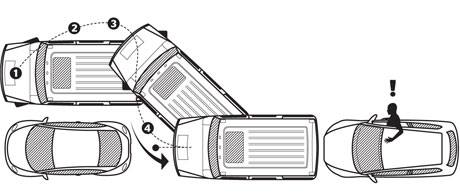Most drivers would attest that parallel parking is possibly one of the hardest parts that they would have to learn in driving. Even experienced drivers would agree that this kind of move actually still brings some sweat out. On the other hand, Complete Driver (Ray Seagrave) suggests that if you would really like to do parallel parking with ease, it is best if you practice. By doing so, you become used to the whole drill and everything comes as second nature to you.
Keeping your mind and concentration on the whole task ahead would help you out do parallel parking. Also, it is important that you are calm and collected as to go through the whole experience.
The 1:2:1 method is one of the easiest methods for carrying out a parallel park and refers to how to steer the wheel. 1 turn left, 2 turns right and finally 1 turn left again. There are also a couple of reference points to use to get a perfect park every time! Here's how its done.
To parallel park, you should use your signal if necessary. This would indicate exactly the direction of the parking space or area that you are intending to park in. If the space is not yet vacant but you notice that the car occupying that spot is about to leave, wait behind the spot so that you can park there. Signal your intention to that driver and any other by indicating left. Turn your signal off when you have put the car into reverse.
Positioning
Image Ref(1) When the space is already vacant, pull ahead of it. Pull up until the nose of your car is just past the end of the car you are reversing behind into the space you are planning on occupying. You can use your left mirror lined up with the front of the car you want to reverse behind as a guide. You should have about two feet of road between your car and the car you pulled up beside.
Reversing
Image Ref(1) Start by putting your car in reverse. After checking all around making observations from your right shoulder begin reversing slowly. As soon you are half way past the vehicle you are at your point of turn. If the car you are reversing behind is parked facing the wrong way, line up your left wing mirror with the target cars right wing mirror. That will put you in the right place.
Turning and reversing toward the kerb
Image Ref(2) Before you turn the wheel again check all around making observations from your right shoulder blind spot around to your left shoulder blind spot. Turn the steering wheel '1 full turn' towards the curb. Look out the back window and around as you reverse. During the whole manouver remember to stop and give way if anything approaches you from any direction (including pedestrians). Assess if it is safe to proceed then carry on.
Image Ref(3) Keep observing as you reverse, the majority of the observation out the back window. When the left door handle (as seen in the left mirror) is completely on the pavement, then turn the wheel right '2 turns' away from the kerb. Reverse back and slowly toward the kerb observing as you go.
Straightening up
Image Ref(4) When you reach this point, turn the steering wheel gradually (1 turn left). You should time the turn of the steering wheel so as the car becomes almost straight along the kerb you have completed the 1 turn off. After looking around, you should pull forward or back into the space centring your car between the cars in front of you and behind you.
Your car should finish a reasonable distance from the kerb (around six to eight inches) when you are parked in the space you chose.
Then practice, practice, practice making little adjustments to the reference points to get the perfect park.
Once again reference points used were:
"Reversing half way past the vehicle you are at your point of turn. then steer left"
"When the left handle is on the pavement as viewed in the left mirror. Then steer right"
"The car is almost straight along the Kurb, steer left once more."
Ray
Ray Seagrave ADI
DSA ADI Car, DSA Fleet Trainer, IAM Advanced Driver, RoSpa GOLD Advanced Driver, DIA member, MSA member,
Complete Driver Training
www.complete-driver.co.uk
‘Teaching with a Passion for Success’
M: 07870861572

 RSS Feed
RSS Feed